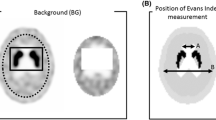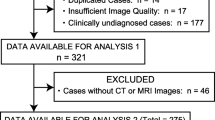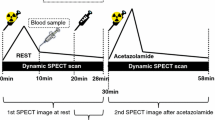Abstract
We aimed to investigate whether the frontal lobe bottom and cerebellum tuber vermis (FLB–CTV) line on brain perfusion scintigraphy, using iodine-123 isopropyl iodoamphetamine single photon emission computed tomography (I-123 IMP SPECT) images, is useful to determine an axial angle parallel to the anterior commissure-posterior commissure (AC–PC) line. We measured the angular differences between the AC–PC line and the FLB–CTV line on midsagittal brain magnetic resonance imaging (MRI) scans of 100 patients. We also evaluated the angular differences of the FLB–CTV line between the IMP SPECT images and the computed tomography for attenuation correction (CTAC) images in the same 100 patients, using a reference line on the CTAC images. Furthermore, the inter-reader reproducibility of the FLB–CTV line measurements on IMP SPECT images of 50 patients between two readers was evaluated using the intra-class correlation coefficient (ICC) and 95% confidence interval (CI). The mean and standard deviation of the angular differences between the AC–PC and FLB–CTV lines on midsagittal brain MRI scans were − 1.24° and 1.14°, respectively. The mean and the standard deviation of the angular differences of the FLB–CTV line in the IMP SPECT and CTAC images were 0.87° and 0.48°, respectively. The ICC of the FLB–CTV line measurements on IMP SPECT images was 0.99 (95% CI 0.98–0.99). We demonstrated that the FLB–CTV line was almost parallel to the AC–PC line and could be reconstructed using IMP SPECT images. The FLB–CTV line can be used as additional evidence to set the axial angle parallel to the AC–PC line.




Similar content being viewed by others
References
Talairach J, Tournoux P. Co-planar stereotaxic atlas of the human brain. New York: Thieme; 1988. p. 122.
Weiss KL, Pan H, Storrs J, Strub W, Weiss JL, Jia L, Eldevik OP. Clinical brain MR imaging prescriptions in Talairach space: technologist- and computer- driven methods. AJNR Am J Neuroradiol. 2003;24:922–9.
Nowinski WL. Modified Talairach landmarks. Acta Neurochir (Wien). 2001;143:1045–57.
Kim YI, Ahn KJ, Chung YA, Kim BS. A new reference line for the brain CT: the tuberculum sellae-occipital protuberance line is parallel to the anterior/posterior commissure line. AJNR Am J Neuroradiol. 2009;30:1704–8.
Friston KJ, Passingham RE, Nutt JG, Heather JD, Sawle GV, Frackowiak RS. Localisation in PET images: direct fitting of the intercommissural (AC–PC) line. J Cereb Blood Flow Metab. 1989;9:690–5.
Minoshima S, Koeppe RA, Mintun MA, Berger KL, Taylor SF, Frey KA, Kuhl DE. Automated detection of the intercommissural line for stereotactic localization of functional brain images. J Nucl Med. 1993;34:322–9.
Funding
The research in this study did not receive any specific aid from funding agencies in the form of grants, equipment, drugs, or any combination of these.
Author information
Authors and Affiliations
Corresponding author
Ethics declarations
Conflict of interest
The authors declare that they have no conflicts of interest.
Research involving human participants
All procedures performed in these studies involving human participants were in accordance with the ethical standards as defined by the Institutional Review Board and the 1964 Helsinki Declaration and its later amendments, or comparable ethical standards.
Informed consent
Formal informed consent was not required at our institution to conduct this kind of study.
Additional information
Publisher's Note
Springer Nature remains neutral with regard to jurisdictional claims in published maps and institutional affiliations.
About this article
Cite this article
Inokuchi, Y., Koya, S., Uematsu, M. et al. Usefulness of the frontal lobe bottom and cerebellum tuber vermis line as an alternative clue to set the axial angle parallel to the AC–PC line in I-123 IMP SPECT imaging: a retrospective study. Radiol Phys Technol 12, 388–392 (2019). https://doi.org/10.1007/s12194-019-00535-5
Received:
Revised:
Accepted:
Published:
Issue Date:
DOI: https://doi.org/10.1007/s12194-019-00535-5




